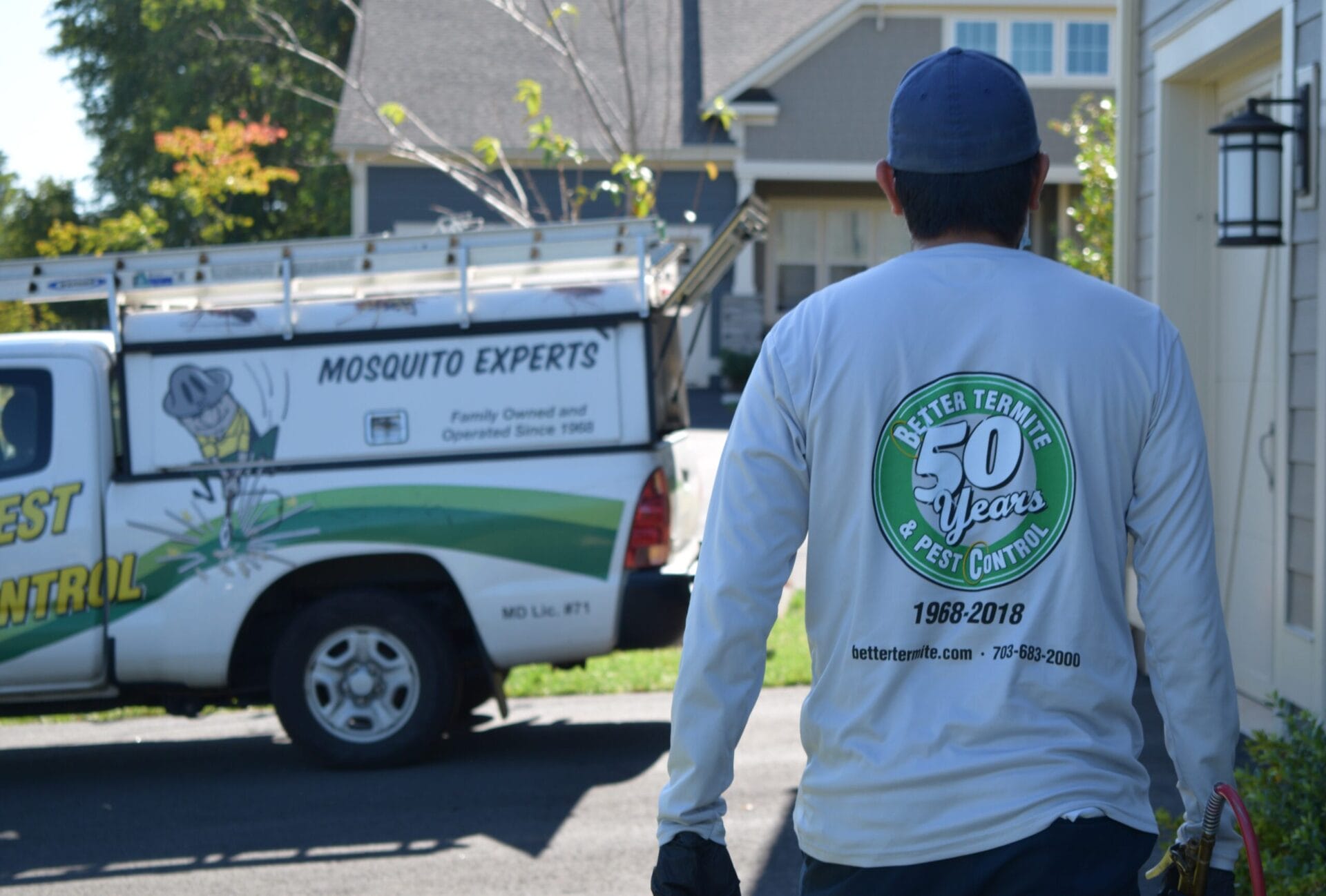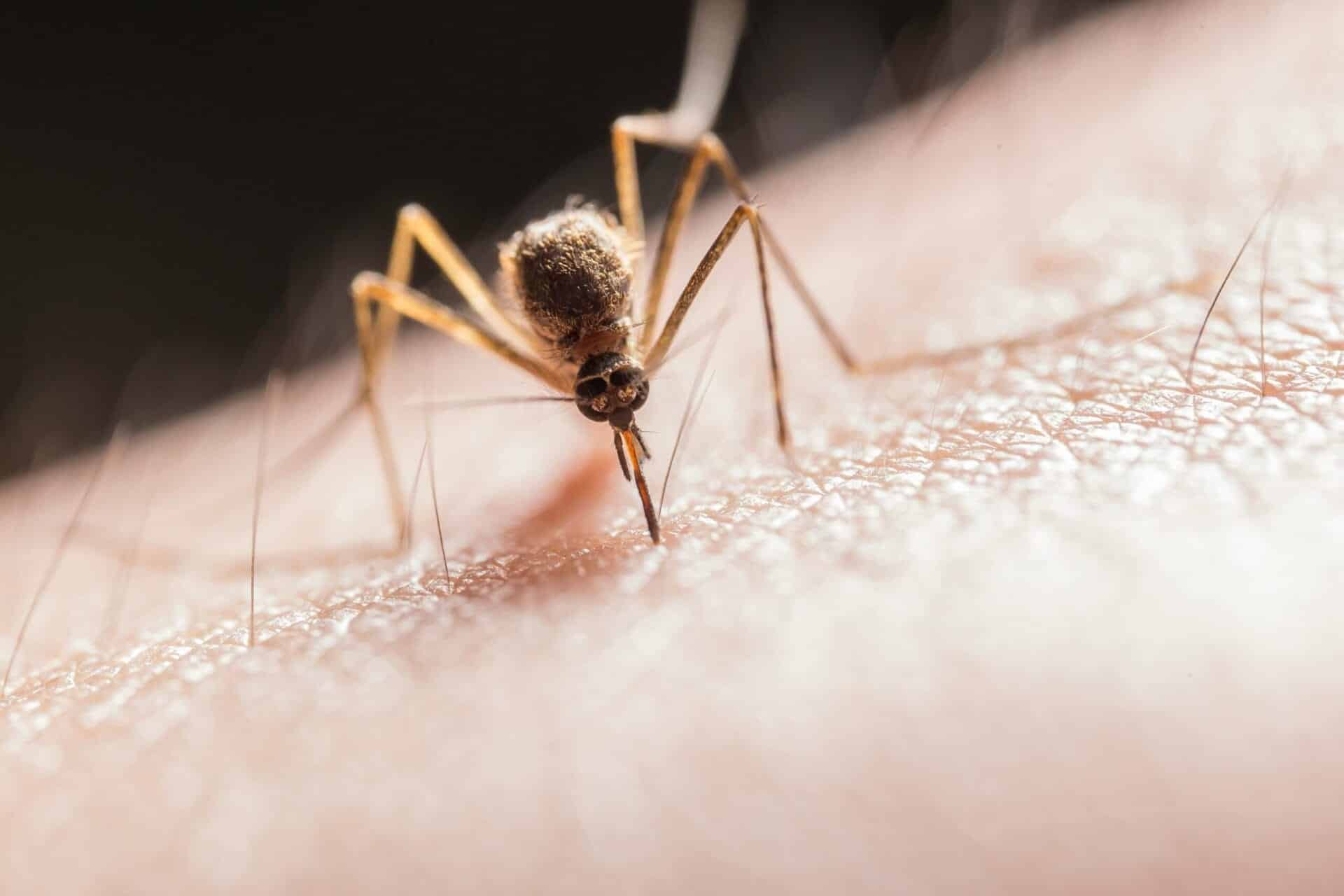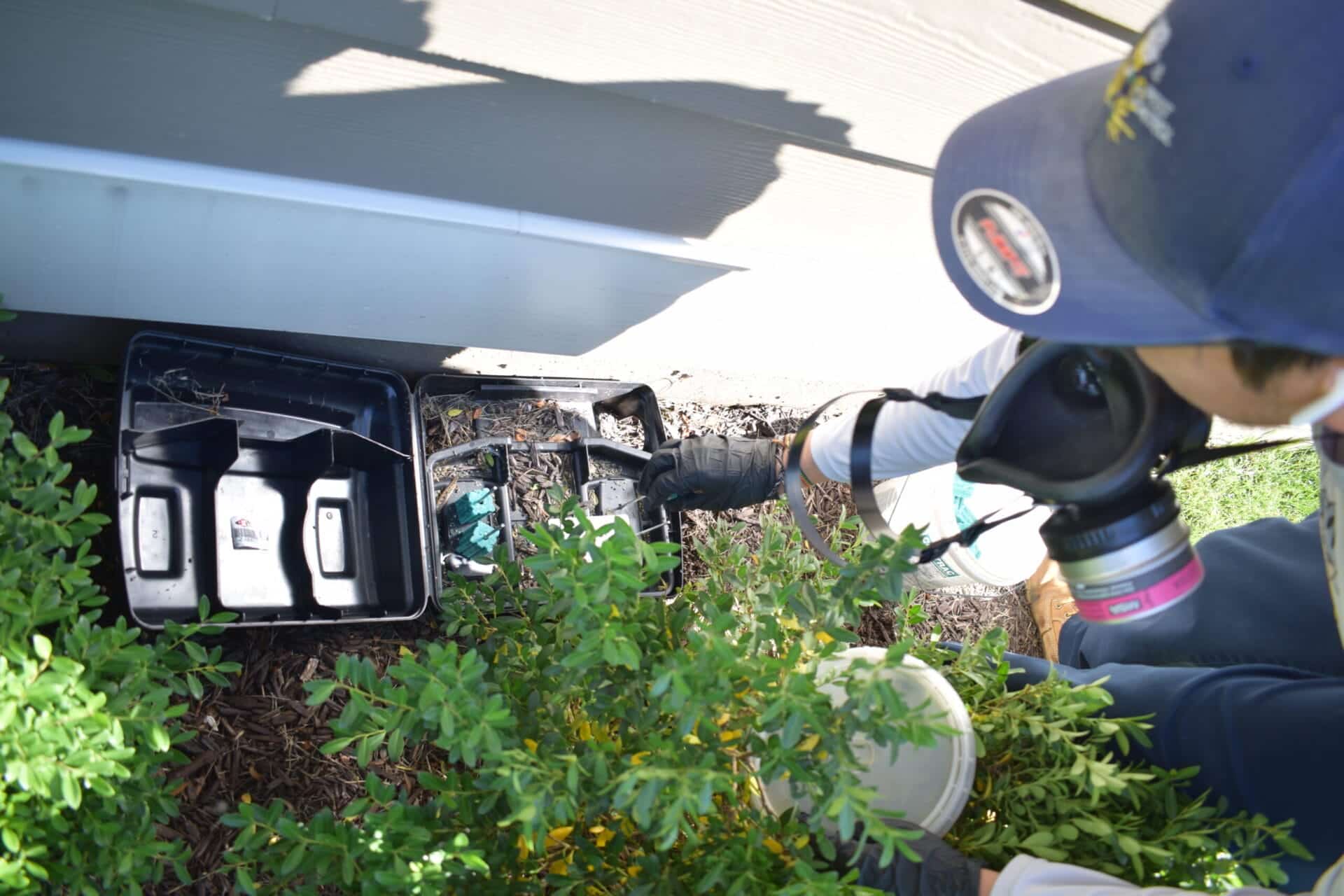


Quick Navigation
When you spot a small moth flying around your home, you need to figure out what type you’re dealing with. Pantry moths and clothes moths look similar at first glance, but they target completely different areas of your home and require different treatment approaches.
In my four years as a registered technician with our family business, I’ve seen countless homeowners misidentify these pests. This confusion often leads to wasted time and money on the wrong solutions.
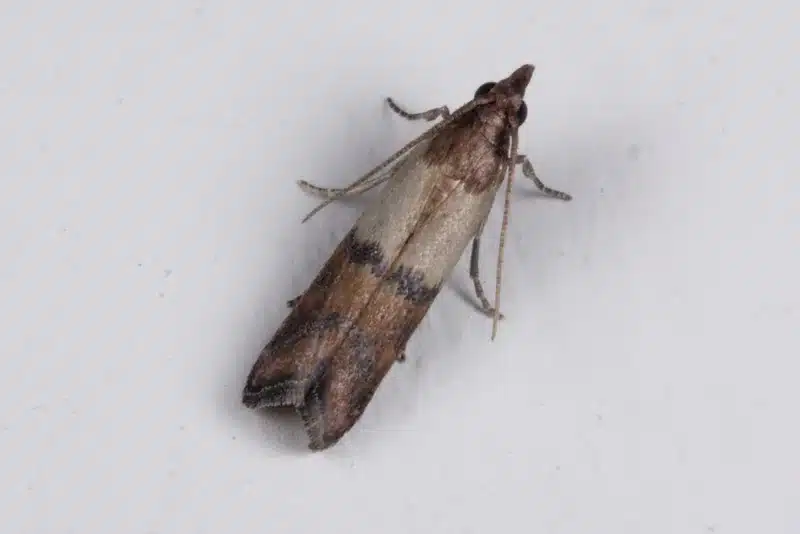
The key to effective pest control starts with proper identification. Moths vs other flying insects requires understanding where you find them, what damage they cause, and how they behave. Let me walk you through the critical differences between these two common household pests.
The most reliable way to tell these moths apart is by looking at their appearance and location. A pantry moth typically measures 8-10 mm in body length with a 16-20 mm wingspan. The telltale sign is their distinctive two-toned forewings – the inner third appears silvery gray while the outer two-thirds shows a copper-reddish color with a dark break line.
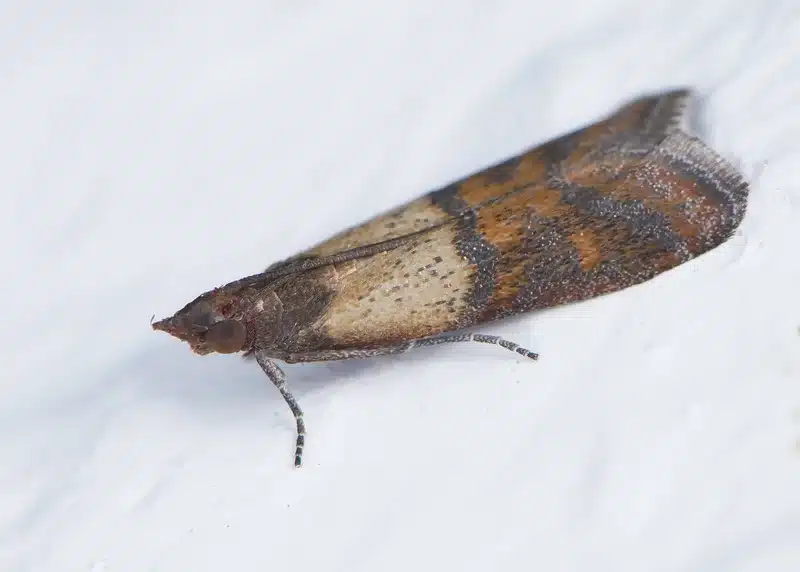

A clothes moth, on the other hand, is smaller with a 6 mm body and 12-14 mm wingspan. Clothes moths look completely different – they have uniform buff-gold wings with narrow fringed margins and a reddish tuft of hair on their head. Unlike pantry moths, clothes moths don’t have the distinctive two-toned pattern.
Behavior also helps you spot the difference. Pantry moths readily fly around kitchen lights and windows, especially in the evening. Clothes moths tend to stay hidden in dark closets and avoid light completely. If you see moths flying around your kitchen, you’re likely dealing with a pantry moth problem.
💡 Quick Identification Tip: The easiest way to tell these moths apart is location and behavior. If you see a moth flying around your kitchen lights in the evening, it’s likely a pantry moth. If you rarely see them but find holes in your woolens, you’re dealing with clothes moths that prefer to stay hidden.
Pantry moths eat dry stored foods, which explains why they’re found in kitchens and pantries. These pests target grain products, cereals, nuts, dried fruits, pet food, and spices. The indian meal moth is the most common pantry pest we encounter in DC area homes.
I often find adult pantry moths near pantry shelves, especially around opened packages. The female moths lay eggs directly on or near food sources. Once the pantry moth larvae hatch, they create webbing as they feed, which gives infested products a clumped or matted appearance.
Clothes moths eat natural animal fibers containing keratin. This includes wool, cashmere, silk, felt, feathers, and fur. They also target items soiled with body oils or food stains, even on synthetic fabrics.
Adult clothes moths prefer dark, undisturbed areas like closet corners, under area rugs, inside upholstered furniture, or in storage boxes. Unlike pantry moths, they avoid well-lit areas and are rarely seen flying in open spaces.

A pantry moth infestation creates distinctive signs in your stored food. Look for loose webbing mats that bind together flour, cereals, or nuts. Infested products often develop a crusty surface layer or clumped texture.
You’ll also notice small holes in packaging, especially in cardboard boxes or plastic bags. Pantry moth larvae leave behind frass (insect waste) and cast skins mixed throughout the food product. These signs indicate it’s time to discard the contaminated items immediately.
A clothes moth infestation produces irregular holes or threadbare patches in natural fabrics. Unlike other fabric pests, clothes moth damage appears as small, round holes that gradually expand. You might find holes in clothing concentrated in areas with body oil residue, like collars or underarms.
The webbing moth creates silk mats on fabric surfaces, while the casemaking moth leaves behind small, cigar-shaped cases made from fabric fibers. Both types leave pepper-like fecal pellets near damaged items.
Both moth types follow similar life cycle stages, but their timing differs significantly. Understanding each pest’s development helps you time treatments effectively.
The pantry moth’s life cycle progresses quickly in heated homes. Eggs hatch within 2-14 days, followed by a 4-6 week larval stage. The larva stage causes all the food damage – adult moth don’t actually eat your stored products.
After pupating for about two weeks, adult pantry moths emerge to mate and lay eggs. This rapid development allows 4-6 generations per year in DC area homes with consistent indoor heating.
The clothes moth development takes much longer. Eggs hatch in 4-10 days, but the larval stage can extend from one month to nine months depending on temperature and humidity. This extended development means you might not notice damage for several months.
Female clothes moths lay fewer eggs than pantry moths but place them directly on suitable fabrics. The slower life cycle typically produces 2-3 generations annually in indoor environments.
According to research published by the University of California Agriculture and Natural Resources, pantry moth development is highly temperature-dependent. At optimal conditions (80-85°F), the complete life cycle can occur in as little as 25-30 days, while cooler temperatures can extend development to 2-3 months.
The Journal of Economic Entomology notes that clothes moth larvae can enter a dormant state during unfavorable conditions, extending their development period significantly. This explains why clothes moth infestations can persist for months without obvious signs, then suddenly appear when environmental conditions become favorable.
Different moth species require specific pheromone traps because they respond to different chemical attractants. Using the wrong trap type won’t effectively monitor your moth problem.
Pantry moth traps use a specific pheromone blend that attracts male indian meal moths. Place these delta-style glue traps near pantry areas, using one trap per 100 square feet of storage space. Male moths get stuck on the adhesive surface, which helps you track infestation levels.
Replace moth trap lures every 8 weeks for continued effectiveness. Remember that traps only capture males, so continued catches after cleaning indicates you’ve missed some breeding sources.
Clothes moth traps require different pheromone formulations for webbing versus casemaking species. The webbing moth and case-bearing clothes moths respond to distinct chemical blends, so you might need multiple trap types.
Clothes moth pheromone traps work best when placed at floor or shelf level in closets and storage areas. These traps help you identify which areas have active infestations and monitor treatment progress.

Successfully preventing each type of moth infestation requires different strategies because these pests target completely different materials and environments.
To prevent a pantry moth problem, inspect every dry goods purchase before bringing items home. Transfer bulk foods to airtight glass or plastic containers within 48 hours of purchase. Moths are attracted to opened packages where they can easily lay eggs.
Rotate your stock using a first-in, first-out system to prevent foods from sitting too long. Consider freezing bulk items like nuts, grains, and spices for one week at 0°F before storage. This eliminates any eggs that might already be present.
Keep pantry shelves clean and vacuum regularly to remove food debris. Moths are found more frequently in cluttered storage areas where spills and crumbs accumulate.
To prevent a clothes moth infestation, clean or dry-clean all woolen items before long-term storage. Moths prefer items with body oils, food stains, or other organic residues. Store clean items in sealed garment bags or airtight containers.
Cedar alone isn’t enough unless used in vapor-tight containers. The natural oils in cedar can help repel moths, but only when concentrated in sealed spaces. Regular cedar blocks or chests don’t maintain sufficient oil concentration.
Vacuum closet floors, carpet edges, and wall junctions regularly. Remove any animal nests from attics or chimneys, as these provide alternative food sources that can support clothes moth populations.
Once you’ve identified which type of moth problem you have, the treatment approach varies significantly between pantry and clothes moth infestations.
To get rid of pantry moths, start by removing all infested food items. Check every package in your pantry, even sealed containers, as moth larvae can chew through cardboard and thin plastic.
Vacuum all shelves, paying special attention to cracks and crevices where moth webbing and larvae might hide. Wipe down surfaces with warm, soapy water. Avoid using insecticide sprays in food storage areas.
Our registered technicians focus on identifying the food source rather than spraying pesticides near your stored food. We help locate missed breeding sites and recommend proper sanitation techniques specific to your situation.
To get rid of clothes moths, begin by identifying all damaged items. Clothes moth larvae often feed in hidden areas, so check inside pockets, folds, and underneath collar areas.
Heat treatment works effectively for valuable items. Place affected clothing in a dryer on high heat for 30 minutes, or freeze items at 0°F for one week. Both methods kill all life stages without using chemicals.
Professional pest control becomes necessary when infestations spread beyond individual clothing items. We can treat wall voids, carpet edges, and other areas where clothes moths might be breeding.
Some moth problems require professional intervention, especially when DIY methods haven’t resolved the issue after several weeks. Our family business has dealt with complex infestations throughout the DC metro area for over 50 years.
Dealing with pantry moths becomes challenging when the food source isn’t obvious. Sometimes larvae develop in forgotten items like old pet food, birdseed, or decorative corn. Our technicians can identify these hidden sources.
For clothes moth issues, professional treatment becomes necessary when damage appears in multiple rooms or when valuable items are at risk. We use targeted treatments that won’t damage your clothing or fabrics.
🔧 Professional Insight: In my experience, the most challenging moth problems involve hidden breeding sources. Pantry moths can develop in decorative corn, pet food stored in garages, or birdseed in basements. Clothes moths often breed in forgotten woolen items, old upholstery, or even animal nests in attics. Our technicians are trained to identify these overlooked sources that keep infestations recurring.

If you’re seeing continued moth activity despite your best efforts, don’t wait for the problem to get worse. Moths can cause significant damage to food supplies or valuable clothing when left untreated.
Understanding the differences between clothes moths and pantry moths helps you choose the right approach for your situation. Whether you’re dealing with contaminated food or damaged fabrics, quick identification and proper treatment will get rid of these pests effectively.
Our team of licensed technicians can help you identify which type of moth you have and develop a targeted treatment plan. We’ve removed 9 of the harshest chemicals commonly used in our industry, choosing alternatives that we’d feel comfortable using in our own homes.
For expert help identifying and eliminating moths in your home, call us at 703-683-2000 or email info@bettertermite.com. We’ll help you get your home back to normal quickly and effectively.
Look at the location where you found the moth and examine its wing pattern. Pantry moths have distinctive two-toned wings (gray and copper-red) and are typically found in kitchens near food. Clothes moths have uniform buff-gold wings and are found in closets or dark storage areas. The damage they cause also differs – pantry moths create webbing in food products while clothes moths make holes in natural fabrics.
No, clothes moth traps won’t work for pantry moths because they use different pheromone attractants. Each moth species responds to specific chemical signals for mating. Pantry moth traps use compounds that attract indian meal moths, while clothes moth traps use different pheromones for webbing or casemaking clothes moths. You need the correct trap type for effective monitoring.
Pantry moths can wander into bedrooms, especially if they’re attracted to lights or if there’s a food source present. However, they typically stay close to kitchens and pantries where their preferred foods are stored. If you’re finding moths in bedrooms regularly, check for forgotten snacks, pet treats, or other food items that might be attracting them. They might also be clothes moths if you store woolens in bedroom closets.
While there’s no instant solution that eliminates an entire pantry moth population, individual moths can be killed immediately by swatting, vacuuming, or using contact sprays. However, the real solution is eliminating their breeding source – the infested food products. Remove and discard all contaminated items, vacuum the pantry thoroughly, and clean all surfaces. This breaks their life cycle more effectively than trying to kill individual flying adults.
No, because the treatment targets are completely different. Pantry moth control focuses on finding and removing infested food products and cleaning food storage areas. Clothes moth treatment involves protecting fabrics, using heat or cold treatments on clothing, and treating areas where natural fibers are stored. The pheromone traps, prevention methods, and treatment chemicals are also specific to each moth type.
Pantry moth elimination typically takes 2-4 weeks if you remove all food sources and clean thoroughly. You might see adult moths for a week or two after cleaning as the remaining larvae complete their development. Clothes moth control takes longer – often 2-3 months – because their life cycle is extended and they can be harder to locate in clothing and storage areas. Professional treatment can speed up the process significantly.
Yes, but the natural methods differ for each type. For pantry moths, proper food storage in airtight containers and regular cleaning work best. Cedar, lavender, and other aromatic herbs can help repel clothes moths when used in sealed storage containers. Freezing works for both types – freeze food items to kill pantry moth eggs or freeze clothing to eliminate clothes moth larvae. However, severe infestations usually require professional intervention.
Pantry moths are attracted to accessible dry food products, especially opened packages of grains, cereals, nuts, and pet food. They often enter homes through already-infested products purchased from stores. Clothes moths are drawn to natural animal fibers like wool, silk, and cashmere, particularly items with food stains, body oils, or perspiration. They can enter through open windows or doors, or be brought in on infested clothing or furniture.
Don’t let moth infestations damage your food or valuable clothing. Our experienced technicians can identify which type you have and create a targeted treatment plan for your DC area home.

With five years of hands-on experience in the pest control industry, George Schulz is a registered technician with the Virginia Pest Management Association and a proud third-generation professional in a family business that’s been protecting homes for over 57 years. He manages and trains a team of service pros while also leading internal research efforts—recently spearheading a deep-dive review of thousands of documents on pest control materials to hand-pick the most kid and pet friendly, most effective solutions tailored specifically for homes in the DC metro area. Read his bio.

